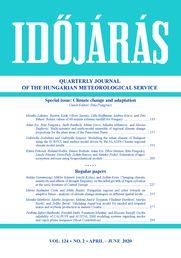IDŐJÁRÁS - angol nyelvű folyóirat
Vol. 124, No. 2 * Pages 143–309 * April - June 2020
 |
Special issue: Climate change and adaptation |
 letöltés [pdf: 3571 KB]
letöltés [pdf: 3571 KB]
Return values of 60-minute extreme rainfall for Hungary
Mónika Lakatos, Beatrix Izsák, Olivér Szentes, Lilla Hoffmann, Andrea Kircsi, and Zita Bihari
DOI:10.28974/idojaras.2020.2.1 (p. 143–)
Mónika Lakatos, Beatrix Izsák, Olivér Szentes, Lilla Hoffmann, Andrea Kircsi, and Zita Bihari
DOI:10.28974/idojaras.2020.2.1 (p. 143–)
Multi-scenario and multi-model ensemble of regional climate change projections for the plain areas of the Pannonian Basin
Anna Kis, Rita Pongrácz, Judit Bartholy, Milan Gocic, Mladen Milanovic, and Slavisa Trajkovic
DOI:10.28974/idojaras.2020.2.2 (p. 157–)
Anna Kis, Rita Pongrácz, Judit Bartholy, Milan Gocic, Mladen Milanovic, and Slavisa Trajkovic
DOI:10.28974/idojaras.2020.2.2 (p. 157–)
Modeling the urban climate of Budapest using the SURFEX land surface model driven by the ALADIN-Climate regional climate model results
Gabriella Zsebeházi and Gabriella Szépszó
DOI:10.28974/idojaras.2020.2.3 (p. 191–)
Gabriella Zsebeházi and Gabriella Szépszó
DOI:10.28974/idojaras.2020.2.3 (p. 191–)
Estimation of agro-ecosystem services using biogeochemical models
Klára Pokovai, Roland Hollós, Emese Bottyán, Anna Kis, Tibor Marton, Rita Pongrácz, László Pásztor, Dóra Hidy, Zoltán Barcza, and Nándor Fodor
DOI:10.28974/idojaras.2020.2.4 (p. 209–)
Klára Pokovai, Roland Hollós, Emese Bottyán, Anna Kis, Tibor Marton, Rita Pongrácz, László Pásztor, Dóra Hidy, Zoltán Barcza, and Nándor Fodor
DOI:10.28974/idojaras.2020.2.4 (p. 209–)
Changing climatic sensitivity and effects of drought frequency on the radial growth of Fagus sylvatica at the xeric frontiers of Central Europe
Balázs Garamszegi, Miklós Kázmér, László Kolozs, and Zoltán Kern
DOI:10.28974/idojaras.2020.2.5 (p. 227–)
Balázs Garamszegi, Miklós Kázmér, László Kolozs, and Zoltán Kern
DOI:10.28974/idojaras.2020.2.5 (p. 227–)
Hungarian regions and cities towards an adaptive future – analysis of climate change strategies on different spatial levels
Mária Szalmáné Csete and Attila Buzási
DOI:10.28974/idojaras.2020.2.6 (p. 253–)
Mária Szalmáné Csete and Attila Buzási
DOI:10.28974/idojaras.2020.2.6 (p. 253–)
Validating AquaCrop model for rainfed and irrigated maize and soybean production in eastern Croatia
Monika Marković, Marko Josipović, Milena Jančić Tovjanin, Vladimir Đurđević, Marija Ravlić, and Željko Barač
DOI:10.28974/idojaras.2020.2.7 (pp. 277–297)
Monika Marković, Marko Josipović, Milena Jančić Tovjanin, Vladimir Đurđević, Marija Ravlić, and Željko Barač
DOI:10.28974/idojaras.2020.2.7 (pp. 277–297)
On the reliability of CALPUFF and AUSTAL 2000 modeling systems regarding smoke and vapor plume mergence
Pedram Jafari Shalkouhi, Farideh Atabi, Faramarz Moattar, and Hossein Yousefi
DOI:10.28974/idojaras.2020.2.8 (p. 299–)
Pedram Jafari Shalkouhi, Farideh Atabi, Faramarz Moattar, and Hossein Yousefi
DOI:10.28974/idojaras.2020.2.8 (p. 299–)
IDŐJÁRÁS folyóirat

Az IDŐJÁRÁS a HungaroMet Nonprofit Zrt. negyedévenként megjelenő angol nyelvű folyóirata
Megrendelhető a journal.idojaras@met.hu címen.
A szerzőknek szánt útmutató itt olvasható.
Megrendelhető a journal.idojaras@met.hu címen.
A szerzőknek szánt útmutató itt olvasható.









